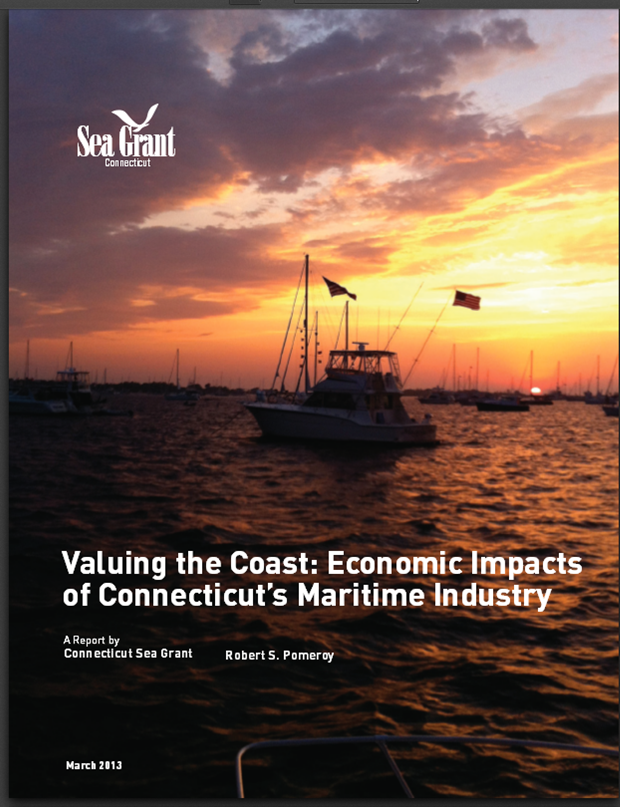Maritime Industry Brings $7 Billion Impact, 40,000 Jobs to Connecticut
/
The value of Connecticut’s maritime economy is nearly $7 billion, according to a new report researched and developed by the University of Connecticut at Avery Point. The industry contributes nearly 40,000 jobs to the state, according to “Valuing the Coast: Economic Impacts of Connecticut’s Maritime Industry issued in conjunction with Sea Grant, a national network comprised of 32 Sea Grant programs based at flagship universities in coastal and Great Lake states and Puerto Rico.
Seven sectors classified by the U.S. Department of Commerce (DOC) as directly related to the state’s maritime in dustry were studied for the report: commercial fishing; seafood product preparation and packaging; ship building and repairing; boat building; transport by water; scenic and sightseeing transportation and support activities for transportation; and amusement and recreational activities.
dustry were studied for the report: commercial fishing; seafood product preparation and packaging; ship building and repairing; boat building; transport by water; scenic and sightseeing transportation and support activities for transportation; and amusement and recreational activities.
Lead author was Robert S. Pomeroy, professor in the Department of Agricultural and Resource Economics in UConn's College of Agriculture and Natural Resources and a Sea Grant college fisheries extension specialist. Pomeroy says the goal of the study was to document the significance of the maritime industry to Connecticut’s economy.
Pomeroy noted that the total impact of the state’s maritime economy is thought to be even higher because this study only looked at seven sectors of the economy. One important area not included is Connecticut’s growing aquaculture industry, which involves farming fish, mollusks, crustaceans, and aquatic plants. The DOC classifies aquaculture as being part of the state’s agricultural industry, so those numbers are not reflected in the findings.
Notably, the research showed that New London County alone accounts for a little less than 50 percent of the total state output impacts. The region consists of 36 towns, including several of the largest cities of the state. Recreati onal activities are the most important sector for Middlesex County, one of four coastal counties most involved in the maritime industry.
onal activities are the most important sector for Middlesex County, one of four coastal counties most involved in the maritime industry.
The total economic output impact, measuring the value of the goods or services produced in each of the sectors studied, resulted in a finding of $6.83 billion at the state level, and $5.88 billion for the four coastal counties most involved in the maritime industry. These include the counties of Fairfield, New Haven, Middlesex, and New London.
Pomeroy and his colleagues used an economic model developed by Nobel Prize-winning economist Wassily Leontif that makes it possible to quantify the interdependencies between different branches of the economy. Leontif’s model shows how the output of one industry serves as an input to each of the other industries in the study. The data used was from 2010.
For Connecticut, ship building for commercial and military purposes is the sector contributing the most to the economy among the seven sectors measured. However, for counties other than New London, the most important sector is transport by water for Fairfield; scenic and sightseeing transport and support activities for transportation in New Haven; and other amusement and recreation industries for Middlesex.
The study also showed that  Connecticut’s maritime industry is an important contributor to employment, with nearly 40,000 people being employed in the industry, of which 32,000 come from the four southernmost counties in the state. Among the seven sectors studied, ship building, which employs approximately 17,600 people, contributes the most jobs to the state’s economy.
Connecticut’s maritime industry is an important contributor to employment, with nearly 40,000 people being employed in the industry, of which 32,000 come from the four southernmost counties in the state. Among the seven sectors studied, ship building, which employs approximately 17,600 people, contributes the most jobs to the state’s economy.
The Sea Grant program is focused on making the United States the world leader in marine research and the sustainable development of marine resources. Joining Pomeroy in authoring the report were Umi Muawanah, a Sea Grant Knauss Fellow, and Nataliya Plesha, a Ph.D. candidate in UConn’s Department of Agricultural and Resource Economics.
For purposes of comparison, a previous study commissioned by the Connecticut Maritime Coalition using 2007 data, reported that Connecticut’s maritime dependent industries were estimated to account for over $5 billion in business output, generating approximately 30,000 jobs. While the two studies used different methodologies, the results are comparable and show the critical economic importance of an evolving maritime industry to the state’s coffers and to providing a stabilizing economic force for Connecticut citizens in otherwise uncertain times.





























